
The extinction of many groups of reptiles, such as dinosaurs or pterosaurs, at the end of the Mesozoic certainly had dramatic effects on the development of early Tertiary ecosystems. Nevertheless, many other groups of reptiles continued to flourish in Paleocene faunas. One of these groups were the turtles, an order technically called Chelonia or Testudines.
The age of the turtles
Turtles are the most abundantly found and most diverse reptiles in Paleocene faunas, and the forms living in streams and ponds seem to have been little affected by the extinction event at the K/T (Cretaceous/Tertiary) boundary. Sediments exposed in the U. S. state of Montana provide a continuous record of this time, with rich turtle faunas both in the latest Cretaceous and in the earliest Paleocene. Although a few genera went extinct at the K/T boundary, the earliest Paleocene turtle fauna still has at least 15 different genera and is more diverse on the generic level than any other Cenozoic turtle fauna, fossil or recent. In addition, the fossil remains of these animals are everywhere, leading one author to the suggestion that this earliest part of the Tertiary should be called the "age of the turtles" (1, 2, 3).

Figure 1: The soft-shelled turtle Palaeotrionyx (now known as Axestemys (20)) from the Paleocene of Western North America. These freshwater turtles closely resembled the living soft-shelled turtles. Length about 45cm. From (21).
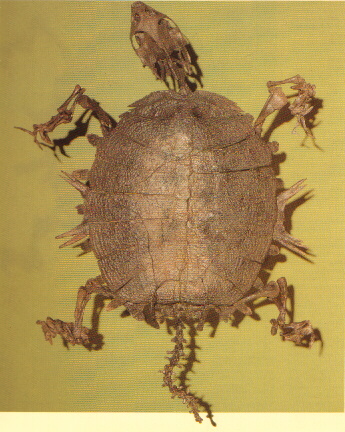 Both modern and
now extinct families of turtles are represented in Paleocene
faunas. Among the modern families, one of the most prominent
groups are the Trionychidae, which are also called soft-shelled
turtles. In these aquatic forms a leathery skin has replaced the
horny plates usually covering a turtle's upper bony shell (the
carapax). In addition, the loss of bony elements normally
encircling their shell results in flexible margins of the flat
disk on top of the animal's body. Like living members of this
family, Early Tertiary trionychids apparently were aquatic
predators, hiding themselves in the mud at the bottom of streams
and lakes and lying there in ambush for their prey. The group was
diverse and widespread in the Paleocene, but fragmentary fossils,
as they are normally found, are difficult to identify. The names
"Trionyx" and "Aspideretes",
both living genera of trionychids, are often applied to early
Tertiary members of the family for practical reasons, without
implying true generic identity of the animals in question. Late
Cretaceous and Early Tertiary specimens of "Aspideretes"
were large forms with a bony shell length of 50cm, with the
complete disk covering the animal still significantly larger.
Small trionychid turtles from the Paleocene of North America may
belong to the extinct genus Plastomenus, originally
described from the Eocene. The lower shell (or plastron),
characteristically reduced in other members of the family, is
still well developed and solidly fused in this unusual trionychid
(1, 2, 4, 5, 6, 7, 8).
Both modern and
now extinct families of turtles are represented in Paleocene
faunas. Among the modern families, one of the most prominent
groups are the Trionychidae, which are also called soft-shelled
turtles. In these aquatic forms a leathery skin has replaced the
horny plates usually covering a turtle's upper bony shell (the
carapax). In addition, the loss of bony elements normally
encircling their shell results in flexible margins of the flat
disk on top of the animal's body. Like living members of this
family, Early Tertiary trionychids apparently were aquatic
predators, hiding themselves in the mud at the bottom of streams
and lakes and lying there in ambush for their prey. The group was
diverse and widespread in the Paleocene, but fragmentary fossils,
as they are normally found, are difficult to identify. The names
"Trionyx" and "Aspideretes",
both living genera of trionychids, are often applied to early
Tertiary members of the family for practical reasons, without
implying true generic identity of the animals in question. Late
Cretaceous and Early Tertiary specimens of "Aspideretes"
were large forms with a bony shell length of 50cm, with the
complete disk covering the animal still significantly larger.
Small trionychid turtles from the Paleocene of North America may
belong to the extinct genus Plastomenus, originally
described from the Eocene. The lower shell (or plastron),
characteristically reduced in other members of the family, is
still well developed and solidly fused in this unusual trionychid
(1, 2, 4, 5, 6, 7, 8).
Figure 2: An excellent specimen of the soft-shelled turtle Trionyx from the Middle Eocene Grube Messel, Germany. Due to the loss of marginal elements of the shell, characteristic bone protrusions can be seen along the edge. Shell length 30cm. From (22)
Two other modern groups of freshwater turtles existing at least since Paleocene times are the snapping turtles and the swamp turtles. The snapping turtles of the family Chelydridae are aquatic ambush predators with large heads, strong jaws and long scaly tails. The living alligator turtle (Macroclemys) is famous for lying in ambush open-mouthed, attracting fish with its moving worm-like tongue until the heavy jaws rapidly close on its prey. This turtle family is generally poorly represented in the fossil record, probably due to the rather solitary behavior seen in the living members, but seems to have originated in North America. Protochelydra is an early representative from the Late Paleocene of North Dakota, and Emarginochelys from the Late Cretaceous to Early Paleocene of North America may be an even earlier member of the group (1, 2, 4, 6, 7, 9).
The swamp turtles of the family Emydidae are turtles of a much more regular build. This family includes today a diverse range of members, most of which are more or less aquatic. They were most diverse during the Paleocene in Asia, making this continent their probable site of origin. Late Paleocene emydids from Asia include the extinct genera Anhuichelys, Hokouchelys and Pseudochrysemys (the latter named in reference to Chrysemys, the well known painted turtle of today). In the Paleocene of North America, swamp turtles are represented by a single unnamed genus (known informally as "Emydid C") that appears in the Middle Paleocene and becomes the most common turtle in the Late Paleocene. This form is unusually large headed, as reflected also in the shell which was strongly indented in front to accommodate the skull. The jaws have simple triturating surfaces, suggesting a mixed diet (4, 7, 8, 10).
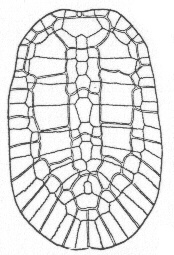 Freshwater turtles
with a more herbivorous diet were represented in the Paleocene by
Adocus, large animals that could reach a shell length of
up to 80cm. Adocus existed from the Late Cretaceous to the
Late Paleocene in North America and survived into the Eocene in
Asia. Its delicately sculptured shell was flattened and lengthened,
with a relatively smooth contour, and the lower shell had large
openings to allow free motion of the limbs. All this suggests
that Adocus was highly aquatic and probably a good
swimmer. Among living turtles, Adocus most closely
resembles the Mesoamerican river turtle Dermatemys of
Mexico and northern Central America, a relict form without living
relatives that is classified in its own family Dermatemyidae. Adocus
has long been considered an early member of the Dermatemyidae,
but it is now usually assigned to its own family Adocidae. The
jaws of Adocus shows the beginning development of more
complex triturating surfaces as they are also found in the
herbivorous Dermatemys. This suggests a similar diet,
though Adocus may still have been more of an omnivore than
the living genus (1, 4, 5, 6, 7, 8).
Freshwater turtles
with a more herbivorous diet were represented in the Paleocene by
Adocus, large animals that could reach a shell length of
up to 80cm. Adocus existed from the Late Cretaceous to the
Late Paleocene in North America and survived into the Eocene in
Asia. Its delicately sculptured shell was flattened and lengthened,
with a relatively smooth contour, and the lower shell had large
openings to allow free motion of the limbs. All this suggests
that Adocus was highly aquatic and probably a good
swimmer. Among living turtles, Adocus most closely
resembles the Mesoamerican river turtle Dermatemys of
Mexico and northern Central America, a relict form without living
relatives that is classified in its own family Dermatemyidae. Adocus
has long been considered an early member of the Dermatemyidae,
but it is now usually assigned to its own family Adocidae. The
jaws of Adocus shows the beginning development of more
complex triturating surfaces as they are also found in the
herbivorous Dermatemys. This suggests a similar diet,
though Adocus may still have been more of an omnivore than
the living genus (1, 4, 5, 6, 7, 8).
Figure 3: Shell of Adocus, a Late Cretaceous to Eocene member of the extinct family Adocidae. Note the lengthened, smoothly contoured shell form of this large aquatic turtle. Double lines show the limits of the horny plates covering the bony shell. The species shown is the Late Cretaceous Adocus punctatus, with a shell length of about 53cm. From (5).
Other extinct groups of Paleocene freshwater turtles include the Baenidae, an exclusively North American family known from the Cretaceous to the Late Eocene. These animals are mainly found in deposits formed by river channels. They had slightly domed and spindle shaped shells, a very long tail and recurved claws at their feet, all suggesting that these were strong, bottom-walking turtles. Baenid turtles were characterized by a curious growth pattern: When adult size was reached, the individual bony plates forming the shell fused and the shell stopped expanding. After this, growth was invested in the thickening of the shell, especially of the lower plastron, resulting in an exceptional thickness of the lower shell in some specimens. Most baenids had massive jaws, and they probably fed on mollusks. Paleocene members from Montana include the genera Plesiobaena, Eubaena, Palatobaena, Stygiochelys and perhaps Neurankylus, all of which successfully crossed the K/T boundary (1, 2, 6, 7, 8). In a unique specimen of the large turtle Neurankylus, found in the early Paleocene of New Mexico, the horny covering of the shell has been fossilized. It still shows the original colour pattern, black spots on a reddish-brown background (11, 12).
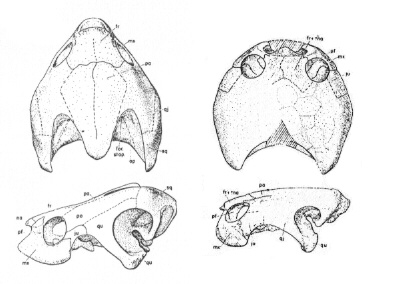
Figure 4: Skulls of two Late Cretaceous to Early Paleocene turtles of the extinct family Baenidae, shown from above (top) and left side (bottom). While the skull of Plesiobaena antiqua (left) was relatively long and narrow, Palatobaena bairdi (right) had a much shorter and broader skull, probably an adaptation to crushing snails and freshwater clams in the latter species (2). From (5), after (23).
Compsemys, a peculiar turtle from the Late Cretaceous to Middle Paleocene of North America (and perhaps the Early Tertiary of Europe), was once considered another member of the Baenidae. However, it has since been removed to the Pleurosternidae, an extinct turtle family reaching back to the Jurassic. The strongly built shell of this moderate-sized form, up to 30cm in length, is covered by raised, flattened tubercles not found in any other turtle, allowing even tiny shell fragments to be identified. The recently found skull of Compsemys shows a striking resemblance to forms such as the above-mentioned alligator turtle, with a sharply hooked beak and high, thin ridges on the jaws. Like its living analogues, Compsemys must have been an aquatic carnivore (1, 5, 6, 7).
Although our knowledge about the turtles from the Paleocene of South America is still limited, there is evidence of two families that still characterize the freshwater faunas of this continent: The snake-necked turtles of the family Chelidae, and the Pelomedusidae (Afro-American side-necked turtles). Both groups are members of the turtle suborder Pleurodira (side-necked turtles) which use a sideways movement of the neck when they protect their head under the shell. All other living turtles belong to the suborder Cryptodira; they use a backward movement when retracting their head. Among the side-necked turtles, most members of the Chelidae have a particularly long neck, which enables them to breathe at the water surface without displaying the remaining body. Paleocene records of this family include the living genus Hydromedusa (South American snake-necked turtle), which first occurs in the early Paleocene of Patagonia. Several different pelomedusid turtles seem to be represented in the Paleocene of South America, including forms similar to the living Podocnemis (South American side-necked river turtles). Both the Chelidae and the Pelomedusidae extend back to the Late Cretaceous of this continent (13, 15, 14).
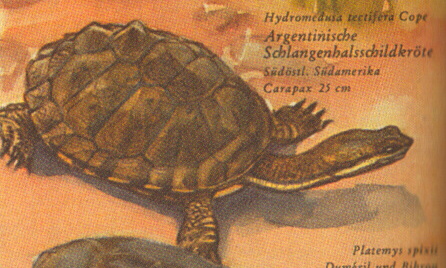
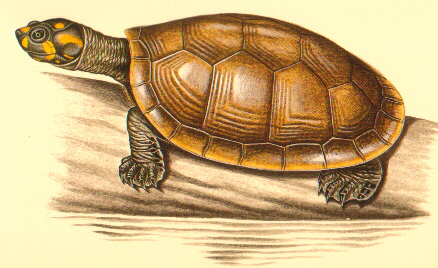
Figure 5 (left): The South American snake-necked turtle Hydromedusa, a side-necked turtle that can be traced back to the early Paleocene of Argentina. The illustrated species is H. tectifera, shell length 25cm. From (24).
Figure 6 (right): The South American side-necked river turtle Podocnemis, another side-necked turtle. Forms similar to Podocnemis are known since the Late Cretaceous in South America. The illustration shows P. unifilis, a species exceeding 70cm in shell length. From (4).
Few terrestrial forms
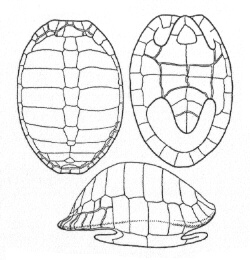 While
freshwater turtles are abundant in Paleocene sediments,
terrestrial forms are rare. Even if animals living in streams and
ponds are much more easily preserved as fossils, the rarity of
land turtles in Paleocene rocks cannot only be an artifact of preservation
but must somehow reflect the true composition of these ancient
turtle faunas. Basilemys, a large terrestrial turtle with
stubby elephantine feet and a shell exceeding 1m in length, had
been present in North America in the Latest Cretaceous. However,
this was one of the few turtles that succumbed to the events at
the K/T boundary, like so many large terrestrial animals (1, 6).
A smaller (shell length 30cm), probably terrestrial turtle that
survived into the Paleocene in North America was Agomphus,
a distant relative of the mud turtles (Kinosternidae). Like in
today's tortoises, the shell of Agomphus is oval in shape,
highly domed and smooth, making similar habits very probable (5,
16). True tortoises of the family Testudinidae do not appear in
North America before the early Eocene, but first members of this
modern family occur in the Late Paleocene of Asia. Their
colonization of the North American continent happened at a time
of sudden warming in the earliest Eocene, when mild climates also
enabled many kinds of mammals to migrate between the northern
continents via landbridges at high latitudes (7).
While
freshwater turtles are abundant in Paleocene sediments,
terrestrial forms are rare. Even if animals living in streams and
ponds are much more easily preserved as fossils, the rarity of
land turtles in Paleocene rocks cannot only be an artifact of preservation
but must somehow reflect the true composition of these ancient
turtle faunas. Basilemys, a large terrestrial turtle with
stubby elephantine feet and a shell exceeding 1m in length, had
been present in North America in the Latest Cretaceous. However,
this was one of the few turtles that succumbed to the events at
the K/T boundary, like so many large terrestrial animals (1, 6).
A smaller (shell length 30cm), probably terrestrial turtle that
survived into the Paleocene in North America was Agomphus,
a distant relative of the mud turtles (Kinosternidae). Like in
today's tortoises, the shell of Agomphus is oval in shape,
highly domed and smooth, making similar habits very probable (5,
16). True tortoises of the family Testudinidae do not appear in
North America before the early Eocene, but first members of this
modern family occur in the Late Paleocene of Asia. Their
colonization of the North American continent happened at a time
of sudden warming in the earliest Eocene, when mild climates also
enabled many kinds of mammals to migrate between the northern
continents via landbridges at high latitudes (7).
Figure 7: Shell of the Late Cretaceous to Paleocene turtle Agomphus from above (left top), bottom (right top) and right side (below). The highly domed, tortoise-like form of the upper shell (or carapax) suggests that this was one of the few land turtles of that time. Shown is Agomphus turgidus from the Late Cretaceous of North America. From (5).
A different type of turtles with apparently terrestrial habits occurs with Planetochelys in the Late Paleocene to Early Eocene of North America. Although of unknown affinities, this highly specialized form closely resembles the living box turtle Terrapene in having developed a hinge in its lower armor. This allowed the animal to completely close its shell after retracting head and tail. The architecture of the shell suggests that this turtle was at least partly terrestrial in habits, which is corroborated by widespread gnawing marks on its fossils made by early rodents. The jaws of Planetochelys form a simple mechanism for triturating, suggesting an omnivorous diet (7, 8).
The most unusual of all Paleocene land turtles must have been the horned turtles of the family Meiolaniidae, even if the early members of this group are still insufficiently known. Spectacular fossils of Meiolania, the type genus of the family, have been unearthed in the Pleistocene of Australia and nearby Lord Howe Island. This giant Late Cenozoic form reached a shell length of about 1m. Its skull featured large horn-like processes, and the tail ended in a bony club. Although best known from these relatively recent members, meiolaniid turtles have a long fossil record that reaches back to the Late Cretaceous of Argentina. Horned turtles persisted as part of the South American reptile fauna until the Early Eocene. Their later presence in Australia is apparently the result of migrations via Antarctica, a continent still ice-free and linked to the other two landmasses in the Early Tertiary (5, 14).
Seagoing turtles
In the marine realm the real giants among the turtles were long gone by the beginning of Paleocene times. In the Late Cretaceous the family Protostegidae had produced huge sea turtles such as Archelon, with a length of the bony shell up to 2,2m, but these forms had already gone extinct before the dramatic turnover at the K/T boundary. However, relatives of the modern sea-turtle family Cheloniidae still flourished in the oceans in the Early Cenozoic. Like the living marine turtles, they were characterized by enlarged forelimbs developed into flippers, a tendency to reduce the massive bony shell inherited from their ancestors and a flattened shell form. Many Mesozoic and Early Cenozoic forms still show a number of primitive features and are therefore often classified in the extinct family Toxochelyidae, although separation from the modern Cheloniidae is problematic. The toxochelyid turtles probably were no particularly good swimmers, and their orbits face to the top, not outward and slightly forward as in modern sea turtles. This suggests that these animals were bottom dwellers in very shallow sea, perhaps somehow comparable in habits to the soft-shelled turtles and snapping turtles of streams and ponds. Osteopygis from Late Cretaceous to Early Paleocene marine sediments of the USA is a typical example of these primitive forms and reached shell lengths of about 70cm. More modern forms are also known from Paleocene sediments. They include remains of a large sea turtle from the Earliest Paleocene of Illinois assigned to Chelonia, the genus to which the recent green sea turtle belongs. Since many cases in which Late Mesozoic or Early Cenozoic reptilian fossils have been assigned to living genera have proven to be mistaken or impossible to confirm, this identification may still require corroboration (5, 17, 18, 19).

Figure 8: The primitive sea turtle Osteopygis emarginatus from the Late Cretaceous to Early Paleocene of the USA. The reconstruction of a partial skeleton (left), seen from below, shows the reduced lower shell (or plastron). The upper bony shell (carapax, right) is little domed and oval in shape, with development of open spaces near the margin as a consequence of shell reduction. Maximum shell length 69cm. After (17).
Modern sea turtles also include a second family, the Dermochelyidae, represented today only by the leatherback turtle Dermochelys. This is the largest living turtle, with a shell length up to 2m. The leatherback turtle shows extreme reduction of the bony shell, and instead of horny plates its shell is covered by a leathery skin, somewhat like in the soft-shelled trionychid turtles. Although the fossil record of the Dermochelyidae is poor, the family has a long evolutionary history, with the earliest members occurring in the Late Cretaceous. Little is known about leatherback turtles for the Paleocene, but the mainly Eocene genus Eosphargis, a large form with a shell length of 1 to 1,5m, may make its first appearance in the Paleocene of the Eastern USA (5, 17, 18).
Surprisingly, Late Cretaceous to Early Tertiary marine turtle faunas include members of a family of side-necked turtles already addressed before: the Pelomedusidae. While this family is restricted to freshwater today, it seems that large pelomedusids were once at home in coastal and shallow marine waters. A particularly widespread form was Taphrosphys, a genus first occurring in the Late Cretaceous of North America but found on both sides of the Atlantic in the Early Cenozoic, including localities in North and South America, Europe and Africa. Species of Taphrosphys had an oval shell without distinct keels that was not strongly domed. The African species Taphrosphys congolensis from the Paleocene of Cabinda, previously known as Bantuchelys, reached a shell length of about 50cm. Together with other pelomedusid turtles it inhabited a shallow inland sea that once stretched across today's Sahara and connected the precursor of the Mediterranean to the Atlantic (5, 16, 18).
A timeless design
Like today, turtles inhabited a diverse range of environments in the Paleocene. The Early Paleocene even saw some of the most diverse freshwater turtle faunas of all times. In total, nearly 50 genera of turtles are known from Paleocene sediments, which corresponds to about 40% of the reptilian genera known from this epoch. Besides several now extinct groups, almost all of the living families of turtles occur by Paleocene times, and several modern genera may be represented. Turtles thus appear to represent a truly timeless and highly successful design, and a design well suited to deal with whatever shook ecosystems on earth 65 million years ago.
First upload 01.04.06
References:
(1) Hutchison, J. H. & Archibald, J. D. 1986: Diversity of turtles across the Cretaceous/Tertiary boundary in northeastern Montana. Palaeogeography, Palaeoclimatology, Palaeoecology 55, 1-22
(2) Archibald, J. D. 1996: Dinosaur Extinction and the End of an Era. What the fossils say. Columbia University Press
(3) Flannery, T. 2001: The Eternal Frontier. An Ecological History of North America and Its Peoples. Atlantic Monthly Press
(4) Cogger, G. H. & Zweifel, R. G. (eds.) 1999: Enzyklopädie der Reptilien & Amphibien. Bechtermünz Verlag
(5) Mlynarski, M. 1976: Testudines. Handbuch der Paläoherpetologie/Handbook of Paleoherpetology, Part 7, Gustav Fischer Verlag
(6) Bryant, L. J. 1989: Non-Dinosaurian Lower Vertebrates Across the Cretaceous-Tertiary Boundary in Northeastern Montana. University of California Publications in Geological Sciences 134
(7) Hutchison, J. H. 1998: Turtles across the Paleocene/Eocene epoch boundary in west-central North America. In: Aubry, M.-P., Lucas, S. & Berggren, W. A. (eds.), Late Paleocene-Early Eocene Climatic and Biotic Events in the Marine and Terrestrial Records, Princeton Univ. Press, 401-408
(8) Holroyd, P. A., Hutchison, J. H. & Strait, S.G. 2001: Turtle diversity and abundance through the Lower Eocene Willwood Formation of the Southern Bighorn Basin. In: Gingerich, P. D. (ed.): Paleocene-Eocene Stratigraphy and Biotic Change in the Bighorn and Clarks Fork Basin, Wyoming. University of Michigan Papers on Paleontology 33, 97-107
(9) Erickson, B. R. 1973: A new chelydrid turtle Protochelydra zangerli from the late Paleocene of North Dakota. Scientific Publications of the Science Museum of Minnesota 2(2), 1-16
(10) Bartels 1983: A transitional Paleocene-Eocene reptile fauna from the Bighorn Basin, Wyoming. Herpetologica 39(4), 359-374
(11) Williamson, T. E. & Lucas, S. G. 1993: Paleocene vertebrate paleontology of the San Juan Basin, New Mexico. In: Vertebrate Paleontology in New Mexico, New Mexico Museum of Natural History and Science Bulletin 2
(12) Sullivan, R. M. 1988: Color pattern on the selmacryptodiran turtle Neurankylus from the early Paleocene (Puercan) of the San Juan Basin, New Mexico. Contributions in Science 401, 1-9
(13) Estes, R. & Báez, A.1985: Herpetofaunas of North and South America during the Late Cretaceous and Cenozoic: Evidence for Interchange? In: Stehli, F. G. & Webb, S. D. (eds.): The Great American Biotic Interchange. Plenum Press, 139-199
(14) de Broin, F. & de la Fuente, M. 1993: Fossil turtles from Argentina: Synthesis. Annales de Paleontologie 79(3), 169-231
(15) de la Fuente, M. & Bona, P. 2002: Una nueva especie del genero Hydromedusa Wagler (Pleurodira, Chelidae) del Paleogene de Patagonia. Ameghiniana 39(1), 77-83
(16) Hutchison, J. H. & Weems, R. 1999: Paleocene turtle remains from South Carolina. In: Sanders, A. E. (ed.): Paleobiology of the Williamsburg Formation (Black Mingo Group; Paleocene) of South Carolina, U. S. A. Transactions of the American Philosophical Society 88, 165-195
(17) Hirayama, R. 1997: Distribution and diversity of Cretaceous chelonioids. In: Callaway, J. M. & Nicholls, E. L. (eds.): Ancient Marine Reptiles. Aademic Press, 225-241
(18) Moody, R. T. J. 1997: The paleogeography of marine and coastal turtles of the North Atlantic and Trans-Saharan regions. In: Callaway, J. M. & Nicholls, E. L. (eds.): Ancient Marine Reptiles. Aademic Press, 259-277
(19) Holman, J. A. 2002: Paleocene turtles and crocodilians directly above the Cretaceous/Tertiary (K/T) boundary in Pulaski County, Illinois. Michigan Academician 34(2), 163-174
(20) Hutchison, J. H. & Holroyd, P. 2003: Late Cretaceous and early Paleocene turtles of the Denver Basin, Colorado. In: Johnson, K. R., Raynolds, R. G. & Michele, L. (eds.): Paleontology and stratigraphy of Laramide strata in the Denver Basin; Part II. Rocky Mountain Geology 38(1), 121-142
(21) Cox, B. (editor) 1988: Illustrated Encyclopedia of Dinosaurs and Prehistoric Animals. Macmillan London Limited
(22) Schaal, S. & Ziegler, W. (editors) 1988: Messel. Ein Schaufenster in die Geschichte der Erde und des Lebens. Verlag W. Kramer, Frankfurt am Main
(23) Gaffney, E. S. 1972: The systematics of the North American family Baenidae (Reptilia, Cryptodira). Bulletin American Museum of Natural History 147, 241-320
(24) Eigener, W. 2004: Enzyklopädie der Tiere. Nikol-Verlag, Hamburg